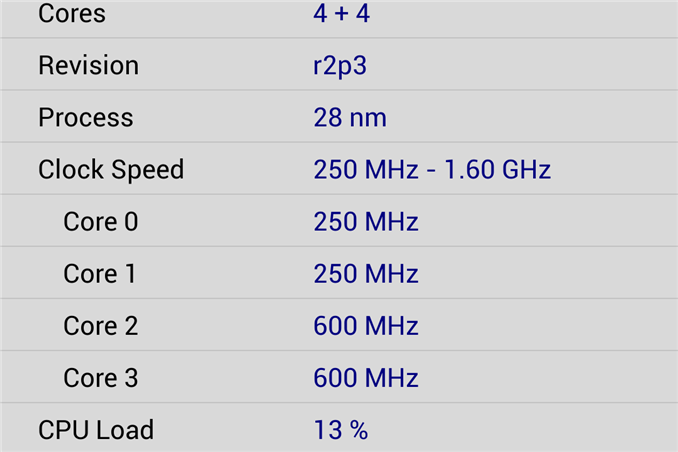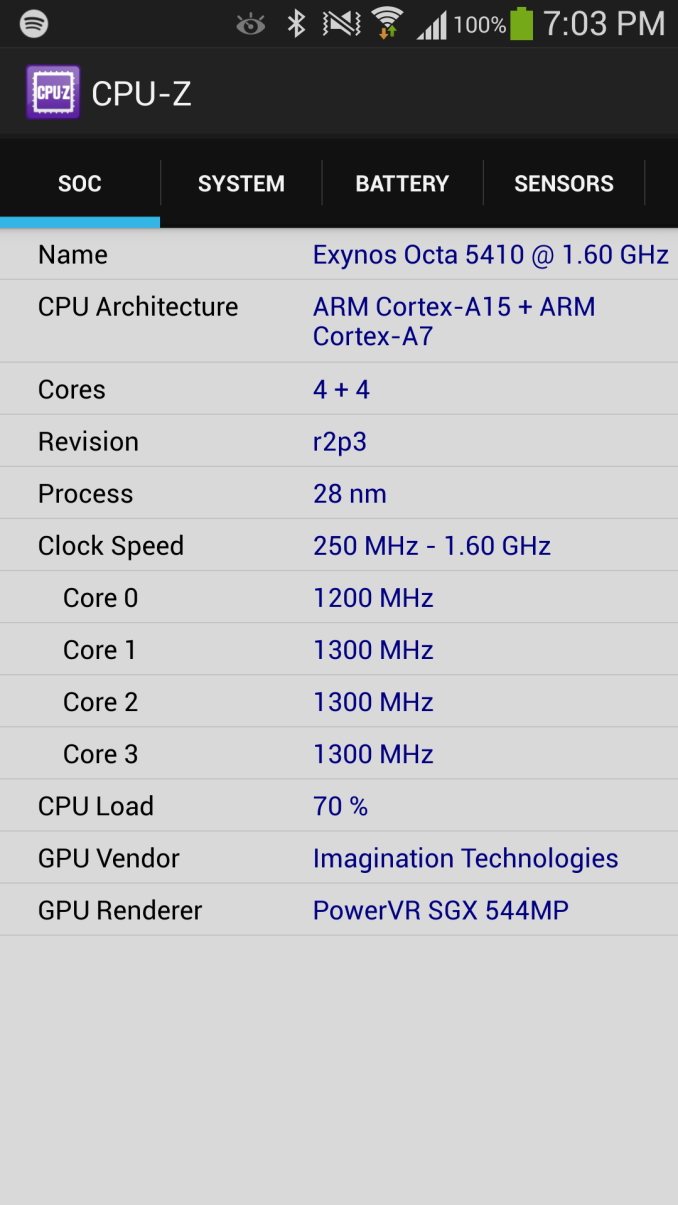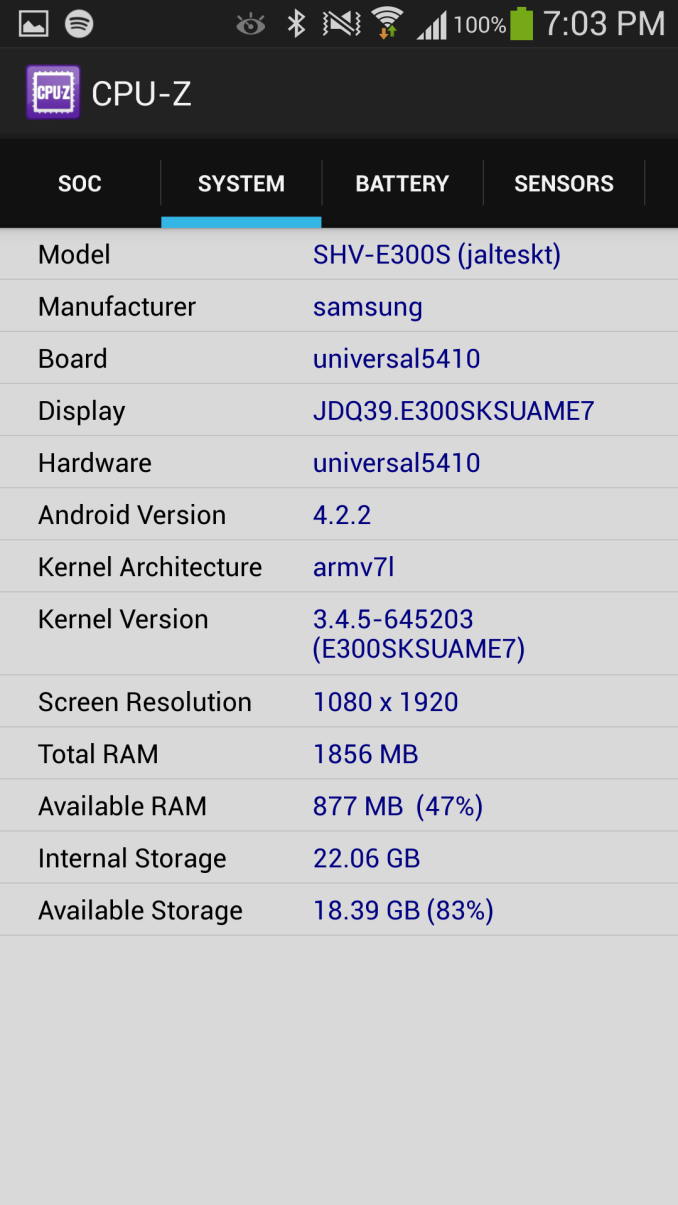CPUID's CPU-Z Arrives on Android via Google Play
by Brian Klug on June 16, 2013 4:50 AM EST- Posted in
- Smartphones
- Android
- Mobile
- Android 4.0
- Tablets
- SoCs

About three years ago, I remember one of the biggest problems I had while sorting out phones was figuring out what SoCs were inside them. Manufacturers weren't yet open to disclosing what silicon was inside, and there wasn't any SoC messaging or branding from any of the numerous silicon vendors. There was a pervasive sense of contentedness everywhere you turned with the current model where what was inside a handset was largely a black box. I remember wishing for a tool like CPU-Z for Android so many times, and I remember trying to explain to someone else just how dire the need was for something like it.
Today vendors and operators are considerably less opaque about what's inside their devices (proving yet again that the 'specs are dead' line is just false hyperbole), but unless you know where to look or who to ask it's still sometimes a mystery. For end users and enthusiasts, there remained the need for something beyond lots of searching, pouring through kernel sources, or kernel messages (dmesg) on devices.
We now have CPU-Z for Android from CPUID, and it works just like you'd expect it to if you're familiar with it on the desktop. There's the SoC name itself, max and min clocks, current clocks for the set of cores, and the other platform details exposed by Android. There are other apps that will get you the same data, but none of them organize it or present it as well as CPU-Z does now.
It isn't perfect (for example, I wish 'Snapdragon 600' devices would show APQ8064T and APQ8064AB when appropriate), but virtually every device I've run it on has popped up with the appropriate SoC and clocks inside. It's clear to me that CPUID is doing some device fingerprinting to figure out what particular silicon is inside, which is understandable given the constraints of the Android platform and the sandbox model. Right now however, CPU-Z for Android is quite the awesome tool.
Source: CPUID, Google Play


















28 Comments
View All Comments
Impulses - Sunday, June 16, 2013 - link
I haven't used a current gen phone on a daily basis yet, but I noticed a huge improvement in general use and multi taking throughout all three previous gen phones I've had... (original single core Snapdragon to dual to Krait) I'm sure RAM and other factors played a role, but I don't know that we've reached that point where mobile performance is "good enough" like we did a few years ago in desktops or even laptops... The smartphone usage model is still evolving rapidly and a lot of heavy processing services and functions are currently being offloaded to cloud services because mobile devices just aren't fast enough. Upgrades to other elements (like display density) also demand fasterhardware, and smartphones are gonna continue to benefit from gains achieved in efficiency and performance even if the target for the latter shifts to tablets and larger devices.Zink - Monday, June 17, 2013 - link
Idle cores barely drain any power with modern power gating and higher frequencies allow hardware to "race to sleep", minimally impacting power consumption. High frequencies and core counts mean I don't have to wait 30 seconds for webpages to load anymore even while installing updates which is nice. Octocore phones in the current gen have been engineered to reduce power consumption, having two different quad cores together is a more power efficient way of providing high performance than one fast quad core.I just installed CPU-Z on my Nexus 4 and I can see two CPU cores running at 1.5 GHz installing updates and running the UI while the other two cores are either "stopped" and completely power gated or running at low frequency to efficiently complete background processes. If needed for tasks like 3D gaming or video editing all four cores can work together on the same task which can provide power savings over 2 high frequency cores. Having a faster processor is often desirable because it reduces the wait time for tasks to complete. Humans have limited time and short attention spans so this is beneficial for most smartphone use cases.
mooninite - Monday, June 17, 2013 - link
If CPU-Z was written by competent individuals they would know to read /proc/cpuinfo for all their CPU details.Calin - Monday, June 17, 2013 - link
I have the LG E-730 (Optimus Sol), and it doesn't give frequency, only the processor as "ARMv7 Processor rev 2 (v71)", 681 BogoMIPS, Features (swp half thumb fastmult vfp edsp neon vfpv3), with CPU implementer: 0x51 and some other hexadecimal values.reggjoo1 - Tuesday, June 18, 2013 - link
I was happy when I saw that cpuz made a android app, until I tried to download it, and found out it doesn't work on gingerbread. If anybody needs a app like this, it's gingerbread, so we can find out certain things that other, less professional app can't tell us, that's the only way these phones can get off of gingerbread, and onto a better version of android.JustCommonSense - Friday, June 21, 2013 - link
Or you could just not use a phone from 2009?chrone - Wednesday, June 19, 2013 - link
i hope they will incorporate soc temperature in the future. :)hefesku - Wednesday, June 26, 2013 - link
super app , now i know samsung is liying , it says pfoa 1 ghz core processor and in fact it is locked at 600 mhz ...